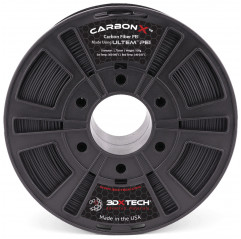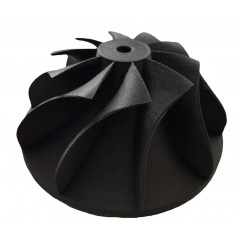Package contains: 1 x CARBONX PEI+CF MADE USING ULTEM 1010 - Black / 1.75mm / 500g - 3DXTech
CarbonX? PEI reinforced carbon fiber (polyether imide) is made using a custom compound consisting of ULTEM? 1010 PEI and high modulus carbon fiber. PEI is a high-performance amorphous polymer that offers excellent mechanical, thermal and chemical resistance properties.
PEI-based filaments offer the ability to create parts with excellent properties even at elevated temperatures, thanks to a high glass transition temperature (Tg) of 217°C. The addition of high-modulus carbon fiber reinforcements significantly increases the stiffness and modulus of the PEI material, as well as improving dimensional stability during and after 3D printing.
Benefits of ULTEM PEI+CF include:
High thermal properties, with a Tg of 217°C
Inherently flame resistant with low smoke evolution and low smoke toxicity
Long-term hydrolytic stability
Excellent dimensional stability, low sensitivity to thermal creep and a very low and uniform coefficient of thermal expansion create highly reproducible part-to-part dimensions
Exceptional strength and modulus, even at elevated temperatures
Good resistance to a wide range of chemicals, including automotive fluids, fully halogenated hydrocarbons, alcohols and aqueous solutions
Stable dielectric constant and dissipation factor over a wide range of temperatures and frequencies
Typical applications for PEI+CF Ultem 1010:
Aerospace:
ULTEM PEI+CF's excellent balance of flame retardant, low smoke emission and low smoke toxicity makes it an excellent candidate for aerospace and aviation applications. ULTEM offers low toxicity, smoke and flame development. Ultem resins can be found in applications such as personal service units, oxygen panels and components, ventilation system components, connectors, cable trays, latches, hinges, food tray containers, door handles and interior trim parts.
Automotive and Transportation:
PEI+CF resins provide automotive manufacturers with a high-performance, chemically resistant, thermally stable and cost-effective metal alternative that is strong enough to replace steel in some applications but light enough to replace aluminum in others. For applications such as transmission components, throttle bodies, ignition components, sensors and thermostat housings.
Electronics:
PEI+CF can be an excellent choice of materials for today's demanding electrical applications, including connectors, MCB components such as housings, shafts and levers, hard drive internals, FOUPs, BiTS, PCBs, MCCB internals, Plenum devices, LCD projector internals, fuel cell components and many other applications.
Filament specifications:
Diameter: 1.75 mm (+/- 0.05 mm)
Recommended print settings:
Extruder: 360-390°C
Platen temperature: 140-160°C
Nozzle: We currently recommend a hardened steel nozzle with a minimum diameter of 0.4 mm
Other: The ideal layer height is 60% of the nozzle diameter. We do not recommend printing layers smaller than 0.2 mm with carbon fiber reinforced filaments
Platen preparation: we recommend using an adhesive or poly tape
Heated chamber: recommended
Media: The ThermaX? HTS is designed to work with complex high-temperature materials
Drying instructions: 120°C for 4 hours
Abrasive material
This material is particularly abrasive among 3D printing filaments. Users may find that standard brass nozzles are chewed up very quickly compared to standard wear. If worn, the nozzle diameter will expand inconsistently and the printer will encounter extrusion problems.
For this reason, we strongly recommend printing this material through a hardened steel nozzle rather than a softer metal. Hardened steel nozzles can often be inexpensive and easy to install depending on the printer manufacturer's instructions.










![CARBONX PA6+CF GEN 3 [CARBON FIBER NYLON] - Black / 1.75mm / 500g - 3DXTech Carbon 3DXTech 19210041 3DXTech](www.dhm-online.com/4900128-home_default/carbonx-pa6-cf-gen-3-carbon-fiber-nylon-black-175mm-500g-3dxtech.jpg)


![CARBONX CF PEKK-A [AEROSPACE] - Black / 1.75mm - 3DXTech 500g Carbon 3DXTech 19210035 3DXTech](www.dhm-online.com/4900124-home_default/carbonx-cf-pekk-a-aerospace-black-175mm-3dxtech-500g.jpg)


![CARBONX PA12+CF [CARBON FIBER NYLON] - Black / 1.75mm / 500g - 3DXTech Carbon 3DXTech 19210040 3DXTech](www.dhm-online.com/4900127-home_default/carbonx-pa12-cf-carbon-fiber-nylon-black-175mm-500g-3dxtech.jpg)




